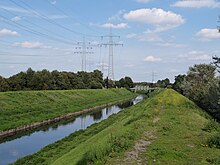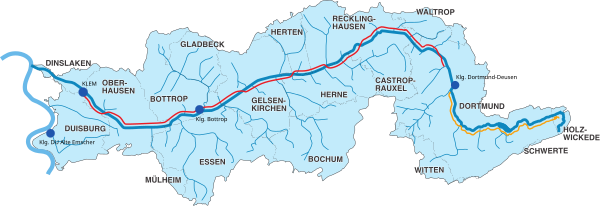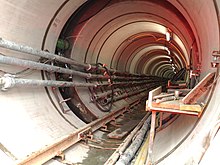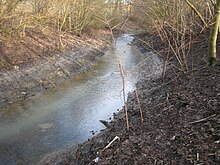Reconstruction of the Emscher system

The ecological reconstruction of the Emscher system consists of the construction of a central wastewater treatment system in the Ruhr area , the construction of underground sewers and the renaturation of the Emscher and its tributaries. It began in 1992 and is expected to be completed by the end of 2021. The investment volume of the project is around EUR 5.38 billion.
history

As a sluggish, meandering river with a slight gradient of 122 meters over 109 kilometers between the source in Holzwickede and the confluence with the Rhine near Duisburg, the Emscher shaped the landscape of the northern Ruhr area until the late 19th century.
In the long sparsely populated meadow landscape, it offered a habitat for a great diversity of species. The medieval chronicler Beurhaus described this landscape as follows:
“The only rivers that exist is the Emscher, which is not yet strong in the local area [...]. But it has pike, eel, lead and other fish, as well as crabs. You can enjoy quite healthy air there and have wonderfully clear water. "
Due to the aforementioned drainage conditions, there was often high water when there was heavy rainfall, which led to the flooding of the nearby areas. Therefore, attempts have been made to regulate the natural course since the middle of the 18th century. The immediate residents of the Emscher were already discharging their wastewater into the river at that time, but only small quantities did not overburden the self-cleaning powers of the water. In the 19th century, however, the population in the Emscher area multiplied in the course of industrialization , for example Dortmund grew from 4,500 inhabitants at the beginning of the century to 66,500 in 1880.
Wastewater from mining and industry was increasingly being discharged into the unpaved Emscher. In 1879, a decision was made in Dortmund to discharge all domestic and commercial wastewater from the city into the river, although it was already classified as sensitive by morphological analyzes at that time. The strongly increased nutrient supply promoted putrefaction and increased algae growth, which significantly changed the chemical composition of the water. In addition, the salt loads discharged from the pits had a negative impact on the natural environment. In particular, the protein-rich wastewater from the breweries ultimately caused the Emscher to overturn .
In 1882 a citizens' initiative wrote a report to the Prussian state parliament describing the annoying circumstances:
“The beautiful, lovely Emscher river from back then is completely muddy and full of mud, a dark, chaotic, yummy, stinky mass creeps lazily through the Emscher bed, and constantly rising bubbles with their perishable breaths continuously pollute the air, especially solid matter, excrement and fertilizer, kitchen waste, rubbish, rubble, ash, inflammable and explosive substances ... "
Regardless of this, large quantities of untreated sewage continued to be discharged into the natural bed of the Emscher. The frequent flooding of entire city districts, which was made worse by the increasing sealing of the large cities, caused extremely unsanitary conditions, especially in Gelsenkirchen, through which diseases such as cholera , typhus and dysentery quickly developed into epidemics, which at the time could often have fatal consequences.
In order to solve this problem and to improve the living conditions of the residents, inter-city wastewater disposal was discussed from the 1880s. However, an underground sewer system seemed impossible, as there was a risk that ongoing subsidence caused by mining would shift the pipe system again and again.
The Emschergenossenschaft was founded in Bochum in 1899 ; henceforth she was responsible for sewage and rainwater management. In 1904 it was also legally anchored in Prussia and immediately began straightening and regulating the Emscher and its tributaries. The engineers developed a trapezoidal fastening with concrete base shells that was easy to implement and inexpensive compared to other sewer systems. Various pumping stations also made it possible to overcome the difficulties of the slight gradient and direct the wastewater to the centrally located sewage treatment plants.
A major disadvantage of this system was the ecological death of the regulated streams, the Emscher as a natural river no longer existed at that time. The strong odor development caused by putrefaction processes and phenol-containing coking plant wastewater also annoyed the Emscher residents, especially on summer days and when the weather was inversion . The unnatural design of the canal as a concrete channel had a very negative impact on the landscape and the open sewers with their steep slopes and slippery concrete elements were a danger to humans and animals. However, for a long time there was no alternative to this solution of regional sewage disposal.
With the foreseeable end of the subsidence after the cessation of hard coal mining in the Emscher area in the 1980s, however, these grievances could be addressed.
New sewage works
By the end of the 1990s, wastewater treatment in the 865 square kilometer Emscher area was realigned to four central wastewater treatment plants:
The Dortmund-Deusen wastewater treatment plant was put into operation in 1994 and, in particular, cleans the wastewater from Dortmund that had previously been untreated into the Emscher . Since then, it has ensured a significantly reduced odor nuisance in the area of the not yet renatured Emscher below Dortmund. The wastewater is supplied through a sewer built parallel to the Emscher from Holzwickede .
The Bottrop sewage treatment plant was built from 1991 to 1996 on the site of the former river treatment plant and purifies the wastewater of the central Ruhr area. The water from the Emscher Canal has also been supplied since 2018.
The Emschermünde sewage treatment plant (KLEM) in the area of the city limits between Dinslaken , Duisburg and Oberhausen was built in 1976 and, when the weather is dry, clears all the water of the not yet renatured Emscher. In 1995 and 2001 it was expanded and modernized. This is where the Emscher Canal ends and feeds all of the wastewater from the Ruhr area to the sewage treatment plant. A pumping station is also being built to pump the clarified water into the Rhine during floods. So far, the sewage treatment plant has been sealed off and the river bypassed it.
The three previously mentioned sewage treatment plants discharge the treated water into the Emscher.
The Duisburg Alte Emscher sewage treatment plant, built in 1936, treats the wastewater from the catchment areas of the former lower reaches of the Alte Emscher and Kleine Emscher , which were separated from the Emscher river system in 1910 and 1949, i.e. mainly from the north of Duisburg and parts of Oberhausen, and discharges the treated water directly into the Rhine .
Emscher sewer
The Emscher sewer (AKE), also known as the Emscher canal , is the central construction project for converting the Emscher system from open to closed sewerage. It runs underground parallel to the Emscher river. The 51 km long canal begins in Dortmund to the north of the Dortmund-Deusen sewage treatment plant and ends in Dinslaken at the Emscher estuary sewage treatment plant and receives the wastewater that was previously discharged directly through the river .
The sewer consists of a reinforced concrete pipe with an inner diameter between 1.4 and 2.8 m. In sections, two tubes were laid in parallel in order to obtain a larger overall cross-section, so that the total length of the canal is over 73 km. It is built with a 1.5 ‰ gradient, so that the sewage flow rate is around 4 km / h. As this gradient is greater than that of the surface, three underground pumping stations are being built in round shafts each about 40 m deep and 50 m in diameter. In Dortmund the canal begins at a depth of around 8 m. The Gelsenkirchen pumping station raises the wastewater from a depth of around 30 m by around 12 m. The Bottrop pumping station pumps the wastewater from a depth of around 32 m to the surface of the Bottrop sewage treatment plant. The Emscher Canal continues towards Dinslaken to a depth of around 20 m. Shortly before the city limits of Dinslaken, the Oberhausen pumping station then lifts the wastewater from a depth of 40 m and routes it to the Emschermünde sewage treatment plant.
Construction started in 2011 in Bottrop; The 35-kilometer section from Dortmund via Castrop-Rauxel to Bottrop went into operation gradually from September 2018, including the Gelsenkirchen and Bottrop pumping stations. The last sewer pipes were laid in August 2019. The Oberhausen pumping station should be ready in mid-2020. Commissioning of the entire system is planned for the end of 2021.
Renaturation of the Emscher
For the Federal Garden Show in Dortmund in 1991, a short section of the Emscher along the Westfalenpark was renatured. Until 2009, however, this section was traversed by only a small amount of water from the surrounding springs. The mixed water from the not yet renatured upper course was led around this section in a sewer.
On December 18, 2009, the renatured, above-ground bed of the Emscher was flooded in Hörde . After the Emscher had flowed under the Hermannshütte at this point for over 100 years , clean water now flows through a near-natural river bed parallel to Lake Phoenix .
At the end of 2011, the main course of the Emscher from the source in Holzwickede to Deusen was renatured over a length of 23 kilometers. The rest of the river is also to be partially renatured. Between 2008 and 2012 the new Emscher passage was built under the Rhine-Herne Canal, which is already prepared with a larger cross-section to accommodate a natural river course.
As part of the Emscherland 2020 action plan , there will also be an ecological redesign of the lower reaches, which will be freed of wastewater after the Emscher Canal has been completed. Due to the drainage conditions, however, it cannot be designed completely naturally with meanders and floodplains , but must remain diked . By widening the dykes and similar rain retention basins, however, the flow velocity should be reduced.
Reconstruction of the tributaries
In addition to the redesign of the 85-kilometer-long river course, the conversion of the Emscher system also includes the renaturation of the tributaries with a total length of over 240 kilometers, most of which are also developed as open wastewater courses.
Before any section of the Emscher is renatured, all of the tributaries that flow into it must be cleared of wastewater. To this end, rain retention basins and sewers that flow into the Emscher sewer (AKE) will be built parallel to the streams. In order to relieve the new sewers, measures have also been started to reduce the discharge of rainwater into the sewer system.
Where the streams are now routed through settlement areas as underground sewers, there is usually no space for a natural design of the stream. If possible, the stream is brought to the surface as urban water. In some cases, however, it is only possible to build an underground clean water course.
As part of the project, smaller streams or headwaters that were never developed as wastewater courses are being made more natural again.
Ready renatured waters
Läppkes Mühlenbach in Essen was renatured as a pilot project between 1989 and 1991. However, the last kilometer of the lower reaches has not yet been redesigned.
The short lower reaches of the Ahbach in Bochum was renatured in 2009. In Dortmund, with the Hörder Bach , Schondelle , Rüpingsbach and Roßbach, all of the tributaries above the Dortmund-Deusen sewage treatment plant have been freed of wastewater.
The renovation of the Deininghauser Bach in Castrop-Rauxel was started in 1992 as a pilot project as part of the IBA Emscherpark and was completed in the area of the upper reaches in 1996. While the entire length of the sewer was completed in 2005, the disclosure of the lower reaches as urban water in the residential area continued until spring 2013.
The renaturation of the Boye tributaries such as the Hahnenbach and the Vorthbach has been completed. The Boye sewer does not flow into the AKE, but directly into the Bottrop sewage treatment plant. In 1996 the renaturation of the Dorneburg Brook began in Bochum and has already been completed from the upper reaches to Herne-Wanne . The environment in Wanne has been upgraded since 2019 with the construction of five new bridges.
In Recklinghausen , the Hellbach with its tributary Breuskes Mühlenbach was renatured from 2005 to 2019 .
The sewer parallel to the Bochum Marbach is ready.
Ongoing renovation work
The reconstruction of the Nettebach in Dortmund took place from 2010 to 2019; Environmental measures are currently (2019) still ongoing. From the end of 2011 to 2014, a clean water canal was driven under the city center of Wattenscheid parallel to the Wattenscheider Bach ; this will be extended to Gelsenkirchen area until 2021. Since the beginning of 2017, the overground conversion of the Berne has been going on from Grillostrasse in Essen.
Remodeling of other waters
In the project for the conversion of the Emscher system , the Alte Emscher and Kleine Emscher with their tributaries were also redesigned accordingly. The catchment area of these former lower courses adjoins that of the Emscher to the southwest, they drain directly into the Rhine via pumping stations.
Despite the close context in terms of content, the redesign of the north-east adjoining catchment area of the Seseke, which drains into the Lippe, between 1986 and 2011 is not counted as part of the project for the conversion of the Emscher system .
Events related to the project
The IBA Emscherpark with the Emscher Landscape Park as well as cycle paths such as the Emscher-Weg and the Emscher Park cycle path took the first measures for the ecological reconstruction of the Emscher area .
The Emscher conversion is a central theme of the route of industrial culture - on the way to the blue Emscher (theme route 13).
The Emscherquellhof , located at the source of the Emscher, was completely renovated in 2005 by the Emschergenossenschaft and is used for exhibitions and as a conference and educational center.
As part of the Capital of Culture year Ruhr.2010 was the Emscherkunst.2010 on the recorded Emscher Island alerted and the current conversion of the Emscher system. The series of events continued in 2013 and 2016. After that, some installations went over to the Emscherkunstweg, such as the observation tower by Tadashi Kawamata at the water cross in Henrichenburg
outlook
The extensive maintenance of the Emscher system is one of the eternal burdens of the Ruhr mining industry. The renaturation of the river course should not hide the fact that a failure of the pumping stations would lead to large-scale flooding with wastewater in the short term, as the subsidence in the Emscher area means that in many places there is no longer a natural gradient.
Web links
Individual evidence
- ↑ a b c d Emschergenossenschaft: The Emscher conversion
- ↑ WAZ: Several milestones for the Emscher conversion in 2018 , November 20, 2018.
- ↑ Peter Wittekampf: The Emscher until the end of the 20th century .
- ↑ Emscher river basin plan, Emschergenossenschaft.
- ↑ Everything flows: The water of the Emscher, Heimat Dortmund , Historical Association for Dortmund and the Grafschaft Mark eV (2006).
- ↑ a b "Everything flows: The water of the Emscher, home Dortmund"
- ↑ a b Schumacher: "Sewers - contemporary witnesses of river history", p. 7
- ↑ Emscher sewer, Emschergenossenschaft.
- ↑ a b Emschergenossenschaft: "Kläranlagen", p. 12
- ↑ Niewerth "Emschervertellekes"
- ↑ Technical data of the Emscher conversion ( Memento of the original from September 1, 2013 in the Internet Archive ) Info: The archive link was inserted automatically and not yet checked. Please check the original and archive link according to the instructions and then remove this notice. on the website of the Emschergenossenschaft, accessed on March 18, 2012.
- ↑ IBA project 023 - Bottrop sewage treatment plant ( Memento of the original dated November 11, 2007 in the Internet Archive ) Info: The archive link was inserted automatically and has not yet been checked. Please check the original and archive link according to the instructions and then remove this notice. on the website of the FH Bochum, accessed on March 18, 2012.
- ↑ Press release of the Emschergenossenschaft from August 29, 2019
- ↑ Billion project: The bed of the Emscher was flooded , Ruhr-Nachrichten Dortmund from December 18, 2009, accessed at RuhrNachrichten.de on March 10, 2012.
- ↑ Integrated action plan ( IHK) Emscherland 2020 ( digitized version )
- ↑ Status of the Emscher conversion ( Memento of the original from April 23, 2010 in the Internet Archive ) Info: The archive link was inserted automatically and has not yet been checked. Please check the original and archive link according to the instructions and then remove this notice. on the website of the Emschergenossenschaft, accessed on March 18, 2012.
- ↑ Handling of rainwater on the Emschergenossenschaft website, accessed on March 18, 2012.
- ↑ Deininghauser Bach ( Memento of the original from June 21, 2015 in the Internet Archive ) Info: The archive link was inserted automatically and has not yet been checked. Please check the original and archive link according to the instructions and then remove this notice. on the website of the M: AI Museum for Architecture and Engineering NRW , accessed on March 11, 2012.
- ↑ Press release of the Emschergenossenschaft from February 27, 2019
- ^ WAZ: On five bridges over the Dorneburg stream
- ↑ Press release of the Emschergenossenschaft from September 30, 2019
- ↑ RN: Soon the Nettebach will be a clean body of water
- ↑ WAZ: The last gaps in the sewer network are gradually closing
- ↑ Berne natural reconstruction is taking on further forms , press release in the WAZ from March 1, 2013, accessed on June 1, 2018.
- ↑ Reconstruction / green corridor Kleine Emscher in the project database Emscher Landscape Park of the Regional Association Ruhr, accessed on March 18, 2012.
- ↑ Die Seseke - data and facts ( Memento of the original from August 28, 2012 in the Internet Archive ) Info: The archive link was inserted automatically and has not yet been checked. Please check the original and archive link according to the instructions and then remove this notice. on the website of the Lippeverband, accessed on March 18, 2012.
- ↑ Emscherkunst
- ^ Tadashi Kawamata: Walkway and Tower






